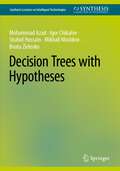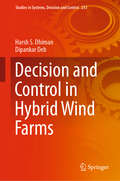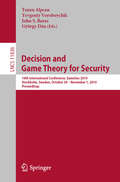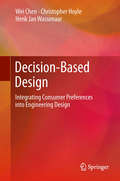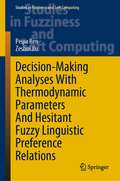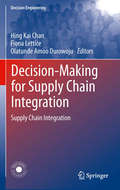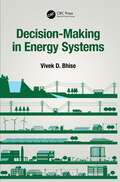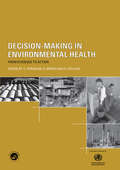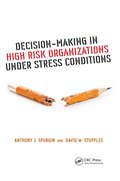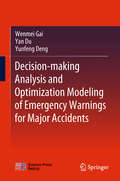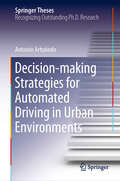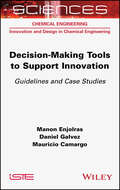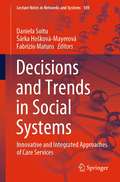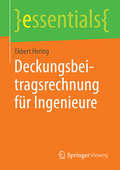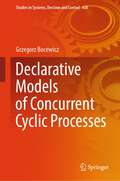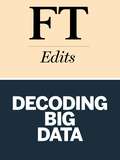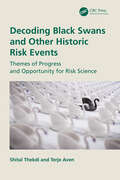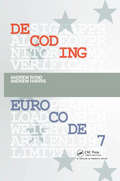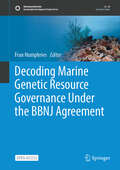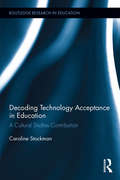- Table View
- List View
Decision Trees for Fault Diagnosis in Circuits and Switching Networks (Studies in Systems, Decision and Control #493)
by Mikhail Moshkov Monther Busbait Albina Moshkova Vladimir ShevtchenkoIn this book, we study decision trees for fault diagnosis in circuits and switching networks, which are among the most fundamental models for computing Boolean functions. We consider two main cases: when the scheme (circuit or switching network) has the same mode of operation for both calculation and diagnostics, and when the scheme has two modes of operation—normal for calculation and special for diagnostics. In the former case, we get mostly negative results, including superpolynomial lower bounds on the minimum depth of diagnostic decision trees depending on scheme complexity and the NP-hardness of construction diagnostic decision trees. In the latter case, we describe classes of schemes and types of faults for which decision trees can be effectively used to diagnose schemes, when they are transformed into so-called iteration-free schemes. The tools and results discussed in this book help to understand both the possibilities and challenges of using decision trees to diagnose faults in various schemes. The book is useful to specialists both in the field of theoretical and technical diagnostics.It can also be used for the creation of courses for graduate students.
Decision Trees with Hypotheses (Synthesis Lectures on Intelligent Technologies)
by Beata Zielosko Igor Chikalov Shahid Hussain Mikhail Moshkov Mohammad AzadIn this book, the concept of a hypothesis about the values of all attributes is added to the standard decision tree model, considered, in particular, in test theory and rough set theory. This extension allows us to use the analog of equivalence queries from exact learning and explore decision trees that are based on various combinations of attributes, hypotheses, and proper hypotheses (analog of proper equivalence queries). The two main goals of this book are (i) to provide tools for the experimental and theoretical study of decision trees with hypotheses and (ii) to compare these decision trees with conventional decision trees that use only queries, each based on a single attribute. Both experimental and theoretical results show that decision trees with hypotheses can have less complexity than conventional decision trees. These results open up some prospects for using decision trees with hypotheses as a means of knowledge representation and algorithms for computing Boolean functions. The obtained theoretical results and tools for studying decision trees with hypotheses are useful for researchers using decision trees and rules in data analysis. This book can also be used as the basis for graduate courses.
Decision and Control in Hybrid Wind Farms (Studies in Systems, Decision and Control #253)
by Dipankar Deb Harsh S. DhimanThis book focuses on two of the most important aspects of wind farm operation: decisions and control. The first part of the book deals with decision-making processes, and explains that hybrid wind farm operation is governed by a set of alternatives that the wind farm operator must choose from in order to achieve optimal delivery of wind power to the utility grid. This decision-making is accompanied by accurate forecasts of wind speed, which must be known beforehand. Errors in wind forecasting can be compensated for by pumping power from a reserve capacity to the grid using a battery energy storage system (BESS). Alternatives based on penalty cost are assessed using certain criteria, and MCDM methods are used to evaluate the best choice. Further, considering the randomness in the dynamic phenomenon in wind farms, a fuzzy MCDM approach is applied during the decision-making process to evaluate the best alternative for hybrid wind farm operation. Case studies from wind farms in the USA are presented, together with numerical solutions to the problem. In turn, the second part deals with the control aspect, and especially with yaw angle control, which facilitates power maximization at wind farms. A novel transfer function-based methodology is presented that controls the wake center of the upstream turbine(s); lidar-based numerical simulation is carried out for wind farm layouts; and an adaptive control strategy is implemented to achieve the desired yaw angle for upstream turbines. The proposed methodology is tested for two wind farm layouts. Wake management is also implemented for hybrid wind farms where BESS life enhancement is studied. The effect of yaw angle on the operational cost of BESS is assessed, and case studies for wind farm datasets from the USA and Denmark are discussed. Overall, the book provides a comprehensive guide to decision and control aspects for hybrid wind farms, which are particularly important from an industrial standpoint.
Decision and Decision-maker in an Industrial Environment
by Lamia Berrah Vincent ClivilléDecision and Decision-maker in an Industrial Environment developed around the observation that two different decision-makers, faced with the same problem, may not make the same decision. The book proposes explanations for this, ranging from the wholly rational to the irrational, and analyzes different factors in decision-making, such as the intention of the decision-maker, the environment in which their decision is made or the process leading to decision-making. While the common belief is that everything in an industrial environment stems from reasoned decisions, analysis of common practice shows that this is not always the case. This book offers an original perspective by presenting the decision making mechanism from the point of view of the decision maker and their handling of a specific decision-making problem. To learn more about the decision-maker’s motivations when faced with these situations, the authors provide a review of the history of decisionmaking and the major trends in decision-making theory. The concepts and methods are presented with illustrations based on the use of an MES, an industrial management software package.
Decision and Game Theory for Security: 10th International Conference, GameSec 2019, Stockholm, Sweden, October 30 – November 1, 2019, Proceedings (Lecture Notes in Computer Science #11836)
by Tansu Alpcan Yevgeniy Vorobeychik John S. Baras György DánThis book constitutes the refereed proceedings of the 10th International Conference on Decision and Game Theory for Security, GameSec 2019,held in Stockholm, Sweden, in October 2019.The 21 full papers presented together with 11 short papers were carefully reviewed and selected from 47 submissions.The papers focus on protection of heterogeneous, large-scale and dynamic cyber-physical systems as well as managing security risks faced by critical infrastructures through rigorous and practically-relevant analytical methods.
Decision-Based Design
by Christopher Hoyle Henk Jan Wassenaar Wei ChenBuilding upon the fundamental principles of decision theory, Decision-Based Design: Integrating Consumer Preferences into Engineering Design presents an analytical approach to enterprise-driven Decision-Based Design (DBD) as a rigorous framework for decision making in engineering design. Once the related fundamentals of decision theory, economic analysis, and econometrics modelling are established, the remaining chapters describe the entire process, the associated analytical techniques, and the design case studies for integrating consumer preference modeling into the enterprise-driven DBD framework. Methods for identifying key attributes, optimal design of human appraisal experiments, data collection, data analysis, and demand model estimation are presented and illustrated using engineering design case studies. The scope of the chapters also provides: A rigorous framework of integrating the interests from both producer and consumers in engineering design, Analytical techniques of consumer choice modelling to forecast the impact of engineering decisions, Methods for synthesizing business and engineering models in multidisciplinary design environments, and Examples of effective application of Decision-Based Design supported by case studies. No matter whether you are an engineer facing decisions in consumer related product design, an instructor or student of engineering design, or a researcher exploring the role of decision making and consumer choice modelling in design, Decision-Based Design: Integrating Consumer Preferences into Engineering Design provides a reliable reference over a range of key topics.
Decision-Making Analyses with Thermodynamic Parameters and Hesitant Fuzzy Linguistic Preference Relations (Studies in Fuzziness and Soft Computing #409)
by Zeshui Xu Peijia RenThe book introduces readers to some of the latest advances in and approaches to decision-making methods based on thermodynamic characters and hesitant fuzzy linguistic preference relations. By investigating the decision-making methods with thermodynamic parameters based on different information representatives, the book offers readers a novel perspective for solving problems under uncertainty. By exploring the consistency and consensus of hesitant fuzzy linguistic preference relations, the book gives readers efficient ways for preference analysis under uncertainty, chiefly intended for researchers and practitioners working in operations research, multi-attribute decision making, preference analysis, etc. The book can also be used as supplementary material for postgraduate and senior-year undergraduate students of the relevant professional institutions.
Decision-Making for Supply Chain Integration
by Fiona Lettice Olatunde Amoo Durowoju Hing Kai ChanEffective supply chain integration, and the tight co-ordination it creates, is an essential pre-requisite for successful supply chain management. Decision-Making for Supply Chain Integration is a practical reference on recent research in the area of supply chain integration focusing on distributed decision-making problems. Recent applications of various decision-making tools for integrating supply chains are covered including chapters focusing on: Supplier selection, pricing strategy and inventory decisions in multi-level supply chains, RFID-enabled distributed decision-making, Operational risk issues and time-critical decision-making for sensitive logistics nodes, Modelling end to end processes to improve supply chain integration, and Integrated systems to improve service delivery and optimize resource use. Decision-Making for Supply Chain Integration provides an insight into the tools and methodologies of this field with support from real-life case studies demonstrating successful application of various decision-making techniques. By covering such a range of topics in this way, Decision-Making for Supply Chain Integration is a useful reference for researchers looking to develop their knowledge or find potential new avenues of research.
Decision-Making for a Sustainable Environment: A Systemic Approach (Social Environmental Sustainability)
by Chris MaserIncreasingly, environmental decision making is like playing a multidimensional game of chess. With interactions between the atmosphere, the litho-hydrosphere, and the biosphere, the game is at once a measure of complexity, uncertainty, interdisciplinary acuity, social-environmental sustainability, and social justice for all generations. As such, it
Decision-Making in Design, Maintenance, Planning, and Investment of Wind Energy (International Series in Operations Research & Management Science #355)
by Daniela BorissovaThis book demonstrates how decision-making models can be applied to solve specific real-life problems, with a particular emphasis on wind energy. In a step-by-step manner, it guides the reader through decision-making, the formulation of optimization models, and the methods for solving them. After providing an overview of various models for the design of wind farms, it presents an optimization model for deciding which economy (country) to invest in and models for selecting suppliers. A dedicated chapter focuses on different models for monitoring and predictive maintenance for wind turbines (farms) due to the construction of turbine blades and vibration. It shows how combinatorial optimization models can help to make optimal decisions for one-dimensional cutting stock of blanks, their processing, and determining the optimal composition for production. Moreover, it discusses how the energy consumption balance index formed by conventional and renewable sources can be determined and presents a means of identifying the relative share of wind energy consumption among the other renewable sources. Operations research professionals, students, and decision-makers alike will find this book to be a valuable resource for tackling real-world challenges and driving sustainable advances in wind energy solutions.
Decision-Making in Energy Systems
by Vivek D. BhiseThis is a comprehensive book on how to make complex decisions on energy systems problems involving different technologies, environmental effects, costs, benefits, risks, and safety issues. Using Industrial and Systems Engineering techniques for decision-making in Energy Systems, the book provides the background knowledge and methods to incorporate multiple criteria involved in solving energy system problems. It offers methods, examples, and case studies illustrating applications. Decision-Making in Energy Systems discusses subjective as well as objective methods, approaches, and techniques taken from the systems and industrial engineering domain and puts them to use in solving energy systems problems. It uses an integrated approach by including effects of all technical, economic, environmental, and safety considerations as well as costs and risks. The book is specially designed for practicing engineers from industrial/systems engineering who work in energy systems engineering industries. Aimed at graduate students, researchers, and managers involved in various energy generating, distributing, and consuming companies, the book helps the reader to understand, evaluate, and decide on solutions to their energy-related problems.
Decision-Making in Environmental Health: From Evidence to Action
by D. Briggs C. Corvalan G. ZielhuisDecision-Making in Environmental Health examines the need for information in support of decision-making in environmental health. It discusses indicators of environmental health, methods of data collection and the assessment of exposure to and the health impact of different environmental risk factors.
Decision-Making in High Risk Organizations Under Stress Conditions
by Anthony J. Spurgin David W. StupplesThis book discusses management decision-making under accident conditions as a vehicle to confirm the importance of clear decision-making guided by a systems approach on how an organization functions related to the role of managers, operators, and the operation of the plant. The book shows how to effectively assess the reliability of an organization particularly those organizations responsible for critical infrastructure. The authors have used Stafford Beer’s cybernetic model as a basis to model the behavior and reliability of such organizations. A series of case studies are used to draw conclusions not only how training, experience, and education can improve the strategy and response of management to reduce the probability of an economic or social disaster, but also draw attention to the fact that managers need to be made aware of the consequences of their decisions. Poor management decisions made under stress conditions can lead to the collapse of an organization together with its underlying business, possibly linked to a social disaster with loss of life. Some technology-ignorant management decisions even under non-stress conditions can lead to dangerous situations, which can increase the economic burden placed on an organization. This book describes such situations in order to promote improvement in organizational preparedness by training, experience, and education to reduce safety and economic risks. This book offers:• Case studies of accidents that have affected different HROs (high-risk organizations) and others, due to poor decision-making by management• Training methods (advocated by Admiral Hyman Rickover, adopted by military bodies and others) to prepare staff to make critical decisions under difficult conditions and examine their applicability to training managers of high-risk facilities• Documentation on how making decisions in difficult situations have psychological constraints related to the degree of preparedness and the tools available to aid the decision maker(s)• Studies on the key actions taken before, during, and after accidents and how these management decisions can affect accident propagation, and how one could improve management decision-making by the use of training in decision-making and an understanding of Ross Ashby’s Law of Requisite Variety.• Simulation techniques to improve training of front-line operators and management• Consideration of cost and investment evaluations and how they can distort the selection of tactics and measures that ensure successful operations and avoidance of accidents
Decision-making Analysis and Optimization Modeling of Emergency Warnings for Major Accidents
by Wenmei Gai Yan Du Yunfeng DengThis book highlights cutting-edge research into emergency early warning management and decision-making for severe accidents. Using toxic gas leakages as examples, it puts forward new design methods for emergency early warning systems, as well as a systematic description of emergency early warning information communication mechanisms and characteristics of regional evacuation, based on a wide range of theories, including safety engineering, information engineering, communication, behaviorology and others. The book applies a range of methods, such as case analysis, questionnaire interviews, and multi-objective optimization modeling. Drawing on this basis, it subsequently proposes a multi-objective optimization modeling and algorithm for emergency path selection, together with an evacuation risk assessment method. Divided into six chapters prepared by an international team of researchers, the book addresses the design of early warning systems, communication and dissemination mechanisms of early warning information, characteristics of regional evacuation, multi-objective optimization of emergency paths, and evacuation risk assessment. The book offers an essential reference guide for engineering technicians and researchers in a wide range of fields, including emergency management, safety science and engineering, disaster relief engineering, and transportation optimization, as well as graduate students in related majors at colleges and universities.
Decision-making Strategies for Automated Driving in Urban Environments (Springer Theses)
by Antonio ArtuñedoThis book describes an effective decision-making and planning architecture for enhancing the navigation capabilities of automated vehicles in the presence of non-detailed, open-source maps. The system involves dynamically obtaining road corridors from map information and utilizing a camera-based lane detection system to update and enhance the navigable space in order to address the issues of intrinsic uncertainty and low-fidelity. An efficient and human-like local planner then determines, within a probabilistic framework, a safe motion trajectory, ensuring the continuity of the path curvature and limiting longitudinal and lateral accelerations. LiDAR-based perception is then used to identify the driving scenario, and subsequently re-plan the trajectory, leading in some cases to adjustment of the high-level route to reach the given destination. The method has been validated through extensive theoretical and experimental analyses, which are reported here in detail.
Decision-making Tools to Support Innovation: Guidelines and Case Studies
by Manon Enjolras Daniel Galvez Mauricio CamargoScientific thinking concerning the way in which we drive innovation has been widely developed in recent years. It is known that the process of innovation consists of a succession of decision-making processes that require simultaneous technical, economical, organizational and sustainable compromises. Indeed, all innovative activities in business require stakeholders to seek out the best compromise between various, often contradictory dimensions of the same problems. Through studying practical cases from various fields (e.g. energy, marketing and sustainable development), this book addresses all the stages of the innovation process, highlighting some of the main decisions that can be faced by organizations. Based on the historical research conducted at the ERPI Laboratory (University of Lorraine) in Nancy, France, this book presents six innovation practices: strategy, creativity, design, project management, human resources and capitalization of knowledge. These practices are then illustrated through examples of decision support methods' applications.
Decisions and Trends in Social Systems: Innovative and Integrated Approaches of Care Services (Lecture Notes in Networks and Systems #189)
by Šárka Hošková-Mayerová Fabrizio Maturo Daniela SoituThis book presents a systemic perspective on the broadly perceived problem of social care, meant in terms of a network engaging balanced resources and actors to assure the functionality, in an integrative approach. The approach involves individual, institutional and organizational structures, at the micro, mezzo- and macro-levels, in their interrelations, with proper contexts for understandings, interpretations and actions by stakeholders. The papers presented suggest ways of changes, involving even participant actors as changing agents, taking into account evolving behaviors and human relations, policies and inter-institutional frameworks, from many points of view. In the first part, various aspects, notably economic and emotional, of innovative and integrated approaches to long-term care are dealt with. Different aspects are considered exemplified by legal, educational, economic, environmental, cultural and those related to the perception of aging, labor market for the elderly, perceived quality of life, etc. The planning and management of social services are discussed in terms of a functional, and effective and efficient system, with the identification and analysis of actors and processes, and transformation policies. This is done at the local, regional and global levels.
Deckungsbeitragsrechnung für Ingenieure (essentials)
by Ekbert HeringDeckungsbeiträge dienen dazu, die Fixkosten eines Unternehmens bzw. der Unternehmensbereiche zu decken. Dazu müssen die fixen und die variablen Kosten bekannt sein. Der Deckungsbeitrag DB errechnet sich aus: DB = Netto-Umsatz - variable Kosten. Diese Kenngröße kann aus der Kostenrechnung leicht ermittelt werden, da Netto-Umsatz und variable Kosten in der Regel bekannt sind. Mit einer mehrstufigen Deckungsbeitragsrechnung können verschiedene Preisuntergrenzen definiert werden. Mit Deckungsbeiträgen können auch Marktpreise kalkuliert und eine Break-Even-Analyse durchgeführt werden (Bestimmung des Break-Even-Umsatzes: Umsatz, bei der gerade kein Gewinn oder Verlust auftritt oder der Break-Even-Stückzahl: Mindeststückzahl bei Gewinn = 0). Ausführliche Beispiele und Grafiken veranschaulichen die Zusammenhänge.
Declarative Models of Concurrent Cyclic Processes (Studies in Systems, Decision and Control #438)
by Grzegorz BocewiczThis monograph presents a new declarative approach dedicated to the analysis of behaviors and synthesis of structures of Systems of Cyclic Concurrent Multimodal Processes (SCCMP). These kinds of problems are some of the most difficult cyclic scheduling problems - both from the computational side and the complexity of the models used. SCCMP is understood as a set of processes (in particular, multimodal processes) that execute operations cyclically on a set of jointly used (shared) resources (processors, machines, means of transport, etc.). They model the functioning of numerous systems encountered in practical settings and which are characterized by cyclic (periodic) behavior. Typical examples are the passenger railway system, the manufacturing system, the transportation system, and etc.Considered problems, i.e., the behavior analysis problem, the structure prototyping problem, and the problem of mutual reachability of various SCCMP behaviors, are strongly NP-hard. This feature implies that computationally-efficient algorithms need to be sought. They would enable the evaluation of selected aspects of the considered system's functions, such as service costs, transport time, etc., in real-time mode.In that context, the presented monograph fills the gap in the field of SCCMP modeling. Its aim is to present declarative models of systems of cyclic multimodal processes. Such models allow the development of computationally-efficient methods of analysis of the behavior and synthesis of the structure of SCCMP. The particular issues raised in this study concern: · Modeling of SCCMP with regular/fractal structures, i.e., structures composed of repeating fragments.· Determining the conditions of mutual reachability of various SCCMP behaviors.· Modeling of SCCMP described by fuzzy variables.The monograph is addressed to researchers, practitioners, and graduate students in operations management, operations research, computer science, and industrial engineering. Declarative models of concurrent cyclic processes will serve as an essential reference for professionals working on cyclic scheduling problems in computer science, manufacturing, communication, and transportation services, as well as in many other areas.
Decline of Agrarian Democracy
by Grant McconnellPresents the history of the agrarian movements from the past centuries to the new transformations; how they came to be and why they were existed and who they represented. A book that sequentially takes the readers through every process of the evolution,.
Decoding Black Swans and Other Historic Risk Events: Themes of Progress and Opportunity for Risk Science
by Terje Aven Shital ThekdiThe field of risk science continues to learn from the long history of events to develop principles and practices that enable individuals, organizations, and societies to understand and manage future risk. Reflecting on these histories reminds us that risk and uncertainty are prevalent, yet it remains important to consider what is on the horizon: the possibility of future events, the consequences of those events, our vulnerability to those events, and how to recover from those events.Decoding Black Swans and Other Historic Risk Events offers a guide to understanding risk events and how to act before they occur. This book explores past risk events and analyzes how risk science principles apply to those events and studies whether current risk science concepts and approaches could potentially have avoided, reduced the impact, or supported recovery following the risk event. New insights are obtained by applying recent research progress in understanding and managing risk, considering aspects including quality of evidence, information, and misinformation in risk studies. The analysis results are used to identify how risk science approaches contribute to the overall management of risk and societal safety, and where improvements can be obtained, allowing the reader to possess a toolkit for identifying and planning for unsafe events.This title will be a critical read for professionals in the fields of occupational health and safety, risk management, civil engineering, mechanical engineering, energy, marine engineering, environmental engineering, business and management, and healthcare.
Decoding Eurocode 7
by Andrew Harris Andrew BondThe purpose and impact of Eurocode 7, the new geotechnical design standard, is explained in this guide. The authors describe the Principles and Application Rules embodied in the standard to show how these differ from traditional (UK) practice.Essential information is brought together and presented succinctly in summary tables and diagrams. Numerous detailed worked examples illustrate important concepts, and are based on an existing design problem for which a traditional solution is known. A critical appraisal is given of the impact of Eurocode 7 on current UK design practice.Selected Contents 1. Introduction 2. Structural design 3. Geotechnical design 4. Design assisted by testing 5. Ground characterization 6.
Decoding Marine Genetic Resource Governance Under the BBNJ Agreement (Sustainable Development Goals Series)
by Fran HumphriesThis open access book provides practical guidance for understanding the new treaty adopted in June 2023 that will change the way biodiversity is governed in about two thirds of the oceans known as areas beyond national jurisdiction (ABNJ). The Agreement under the United Nations Convention on the Law of the Sea on the Conservation and Sustainable Use of Marine Biological Diversity of Areas Beyond National Jurisdiction is an achievement for global cooperation in conservation, sustainability and equity. The treaty provisions in Part II on Marine Genetic Resource (MGR) governance were the most contentious element of negotiations, resulting in significant innovation and compromise. It has an ambitious framework with many details yet to be fleshed out after the treaty comes into force. There is no comprehensive guidance for stakeholders about what the treaty means for their current and future research and development (R&D) and commercialisation of MGR of ABNJ, digital sequence information and associated traditional knowledge. Through a detailed commentary and real world examples, this book interprets and analyses the treaty text to offer practical considerations, guidelines and tools to assist policy makers as well as scientists and commercial end users to align their R&D practices with the expected implementation of the treaty.
Decoding Technology Acceptance in Education: A Cultural Studies Contribution (Routledge Research in Education)
by Caroline StockmanThe process of integrating technology into education often overlooks that technology is a sign; it is not a neutral message conveyor, but rather a material artefact placed into a context inevitably subject to culture. In an original and novel combination, Decoding Technology Acceptance in Education brings together two academic domains not previously pursued together, yet which diverge in many ways: cultural studies and technology acceptance studies. Drawing on empirical data, Stockman demonstrates that teachers activate a meaning-making process through encoding and decoding signs around technology as an artefact of culture, and as a result their acceptance behaviour and decisions rely on the dynamics of the cultural whole to which they belong. In this study, technology acceptance is revisited as an issue of cultural negotiation; the common approach, which provides an instrumental view on technology as a neutral tool, is insufficient for the topic of technology acceptance. Rather than proposing yet another model of technology acceptance, Decoding Technology Acceptance in Education offers a renewed frame of mind and the conclusions it provides are of vital importance to the theoretical and practical advancement of technology acceptance studies, as well as to the practical integration of technology into education. Providing original empirical evidence for the influence of culture on educational decision-making, the book raises awareness for the importance of cultural research in areas where it has been under-considered. This book will be of great interest to researchers, academics and postgraduate students engaged in the study of technology acceptance and technology use in education, as well as those interested in cultural studies.

